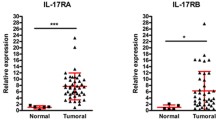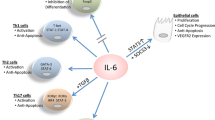Abstract
IL-4 is a pleiotropic cytokine produced by T lymphocytes which acts on various cells of such as T and B lymphocytes, monocytes, fibroblast, endothelial cells, macrophages and some others. IL-4 was originary described as a B cell growth factor, and now known to provide potent anti-tumor activity against various tumors, including breast cancer. IL-4 can induce apoptosis in cultured breast cancer cells. In addtion, it has been clarified that IL-4 plays an important role in the regulation of estrogen synthesis enzymes including 17 β-HSD and 3 β-HSD. These findings imply that IL-4 is a key enzyme not only for Th2 type immune reactions but also for tumor cell growth itself in human breast cancer.
Similar content being viewed by others
Abbreviations
- IL:
-
Interleukin
- TNF:
-
Tumor necrosis factor
- IFN:
-
Interferon
- TCR:
-
T cell receptor
- TGF:
-
Transforming growth factor
- IGF:
-
Insulin-like growth factor
- IRS:
-
Insulin receptor substrate
- ICAM:
-
Intercellular adhesion molecule
- VCAM:
-
Vascular cell adhesion molecule
- ELAM:
-
E-selectin
- VEGF:
-
Vascular endothelial cell growth factor
- HSD:
-
Hydroxysteroid dehydrogenase
Reference
Howad M, Farrar J, Hilfiker M,et al: Identification of a T cell-derived B cell stimulatory factor distinct from IL-2.J Exp Med 155:914–923, 1982.
Yokota T, Arai N, de Vries J,et al: Molecular biology of interleukin-4 and interleukin-5 genes and biology of their products that stimulate B cells, T cells and haematopoietic cells.Immuno Rev 102:137–138, 1988.
Coffman RL, Seymour B, Lebman DA,et al: The role of helper T cell products in mouse B cell differentiation and isorype regulation.Immuno Rev 102:5–28, 1988.
Snpper CM, Finkelman FD, Paul WE: Regulation of IgG1 and IgE production by interleukin 4.Immunol Rev 102:29–56, 1988.
Noma Y, Sidras P, Naito T,et al: Cloning for cDNA encoding the murine IgG 1 induction factor by a novel strategy using SP6 promoter.Nature 319:640–644, 1986.
Mosmann TR, Coffman RL: TH1 and TH2 cells: difference patterns of lymphokine secretion lead to different functional properties.Ann Rev Immmunol 7:145–173, 1989.
Paliard X, De Waal MR, Yssel H,et al: Simultaneous production of IL-2, IL-4 and IFN-gamma by activated human CD + and CD+T cell clones.J Immunol 141:849–855, 1988.
Lewis DB, Prickett KS, Larsen Aet al: Restricted production of interleukin-4 by activated human T cells.Proc Natl Acad Sci USA 85:9743–9747, 1988.
van der Heijden FL, Wierenga EA, Bos JD,et al: High frequency of IL-4 producing CD4+allergen-specific T lymphocytes in atopic dermatitis lesional skin.J Invest Dermatol 97:389–394, 1991.
Banchereau J: Interleukin 4.Nucl Med Biol 17:619–623, 1990.
Lownthal JW, Castle BE, Christiansen J,et al: Expression of high affinity receptors for murine interleukin 4(BSF-1) on haematopoietic and non-haematopoietic cells.J Immunol 140:456–464, 1988.
Park LS, Friend D, Sassenfeld HM,et al: Characterization of the high affinity cell surface receptor for murine B cell stimulatory factor-1.Proc Natl Acad Sci USA 84:1669–1673, 1987.
Cabrillat H, Galizzi JP, Djossou O,et al: High affinity binding of human interleukin 4 to cell lines.Biochem Biophys Res Commun. 149:995–1001, 1987.
Idzerda RL, March CJ, Mosley B,et al: Human interleukin 4 receptor confers biological responsiveness and defines a novel receptor superfamily.J Exp Med 171:861–873, 1990.
Galizzi J-P, Zuber CE, Harada N,et al: Molecular cloning of a cDNA encoding the human IL-4 receptor.Int Immunol 2:669–675, 1990.
Bazan JF: A novel family of growth factor receptors: a common binding domain in the growth hormone, prolactin, erythropoietin and IL-6 receptors and the p75IL-2 receptor beta-chain.Biochemical and Bilphys Res Commun. 164:788–795, 1989.
Topp MS, Koenigsmann M, Anthony M,et al: Recombinant human interleukin-4 inhibits growth of some human lung tumor cell lines in vitro and in vivo.Blood 82:2837–2844, 1993.
Obiri NI, Siegel JP, Varricchio F,et al: Expression of high-affinity IL-4 receptors on human melanoma, ovarian and breast carcinoma cells.Clin Exp Immunol 85:148–155, 1994.
Obiri NI, Hillman GG, Haas GP,et al: Expression of high-affinity interleukin-4 receptors on human renal cell carcinoma cells and inhibition of tumor cell growth in vitro by interleukin-4.J Clin Invest 91:88–93, 1993.
Varricchio F, Obiri NI, Haas GP,et al: Immuno-staining of interleukin-4 receptors on human renal cell carcinoma.Lympyokine Cytokine Res 12:465–469, 1993.
Toi M, Bicknell R, Harris AL: Inhibition of colon and breast carcinoma cell growth by interleukin-4.Cancer Res 52:275–279, 1992.
Mat I, Larche M, Melcher D: Tumor associated upregulation of IL-4 receptor complex.Br J Cancer. 62 (supple x): 96–98, 1990.
Kaklamanis L, Koukourakis MI, Leek R: Loss of interleukin-4 receptor-associated molecule gp200-MR6 in human breast cancer; Prognostic significance.Br J Cancer 74:1627–1631, 1996.
Tubly A, Luqmani YA, Shousha S,et al: Differential expression of gp200-MR6 molecule in benign hyperplasia and down-regulation in invasive carcinoma of the breast.Br J Cancer 74:1005–1011, 1996.
Jung T, Bews JP, Enssle KH,et al: Detection of and discrimination between total and free human interleukin 4 and free soluble interleukin 4 receptor by EUSA.J Immunol Method 217:41–50, 1998.
Jung T, Wagner K, Neumann C,et al: Enhancement of human IL-4 activity by soluble IL-4 receptorsin vitro.Eur J immnol 29:864–871, 1999.
Jung T, Schrader N, Hellwing M,et al: Soluble human interleukin 4 receptor is produced by activated T cells under the control of metalloproteinases.Int Arch Allergy Immunol 119:23–30, 1999.
Zlotnick A, Ransom J, Frank G,et al: Interleukin 4 is a growth factor for activated thymocytes: Possible role in T cell ontogeny.Proc Natl Acad Sci USA 84:3856–3860, 1987.
Spits H, Yssel H, Paliard X,et al: IL-4 inhibits IL-2 mediated induction of human lymphokine-activated killer cells, but not the generation of antigen specific cytotoxic T lymhocytes in mixed lymphocyte cultures.J Immunol 141:29–36, 1988.
Brown M, Hu-Li J, Paul WE: IL-4/B cell stimulatory factor-1 stimulates T cell growth by an IL-2 independent mechanism.J Immunol 141:504–511, 1988.
Widmer MB, Grabstein KH: Regulation of cytolytic T lymphocytes generation by B cell stimulatory factors.Nature 326:795–798, 1987.
Lee F, Yokota T, Otsuka T,et al: Isolation and characterization of a mouse interleukin cDNA clone that express B-cell stimulatory factor 1 activities and T-cell and mast-cell stimulating activities.Proc Natl Acad Sci USA 83:2061–2065, 1986.
Paul WE, Ohara J: B-cell stimulatory factor-1/interleukin 4.Ann Rev Immunol 5:429–459, 1987.
Santin AD, Ioli GR, Hiserodt JC,et al: Development and characterization of an IL-4 secreting human ovarian carcinoma cell line.Gynecol Oncol 58:230–239, 1995.
Golumbek PT, Lazenby AJ, Levitsky HI,et al: Treatment of established renal cancer by tumor cells engineered to secrete interleukin 4.Science 254:713–716, 1991.
Tepper RI, Pittengale PK, Leder P: Murine interleukin4 displays potent anti-tumor activityin vivo.Cell 57:503–512, 1989.
Blais Y, Gingras S, Haagensen DE,et al: Interleukin-4 interlelukin-13 inhibit estrogen-induced breast cancer cell proliferation and stimulate GCDFP-15 expression in human breast cancer cells.Mol Cell Endocrinol 121:11–18, 1996.
Topp MS, Papadimitriou CA, Eitelbach F,et al: Recombinant human interleukin 4 has antiproliferative activity on human tumor cell lines derived from epithelial and nonepithelial histologies.Cancer Res, 55:2173–2176, 1995.
Cressent M, Pidoux E, Cohen R,et al: Interleukin-2 and interleukin-4 display potent antitumor activity on rat medullary thyroid carcinoma cells.Euro J Cancer 31A:2379–2384, 1995.
Klara T, Bharat BA: Interleukin4 potentiates the antiproliferative effect of tumor necrosis factor on various tumor cell lines.Cancer Res 51:4266–4270, 1991.
Gooch JL, Lee AV, Yee D: Interleukin4 inhibit growth and induce apoptosis in human breast cancer cells.Cancer Res 58:4199–4205, 1998.
Blais Y, Zhao C, Huber M,et al: Growth-independent induction of spermidine transport by IL-4 and IL-13 in human cancer cells.Int J Cancer 67:532–538, 1996.
Pericle F, Giovarelli M, Colombo MP: An efficient Th2-type memory follows CD8 + lymphocyte-deriven and eosinophil-mediated rejection of a spontaneous mammary adenocarcinoma engineered to release IL-4.J Immunol 153:5659–5673, 1994.
Allione A, Consalvo M, Nanni P,et al: Immunizing and curative potential of replicating and nonreplicating murine mammary adenocarcinoma cells engineered with IL-2, IL-4, IL6, IL-7, IL-10, tumor necrosis factor alpha, granulocyte-macrophage colony-stimulating factor, and gamma-interferon gene or admixed with conventional adjuvants.Cancer Res 54:6022–6026, 1994.
Musiani P, Allione A, Modica A,et al: Role of neutrophils and lymphocytes in inhibition of a mouse mammary adenocarcinoma engineered to release IL-2, IL-4, IL-7, IL10. IFN-alpha, IFN-gamma, and TNF-alpha.Lab Inves 74:146–157, 1996.
Maeda T, Matsubara H, Sugaya M: Loss of tumorigenecity of human breast cancer cells engineer to produce IL-2, IL-4 or GM-CSF in nude mice.Int J Oncol 15:943–7, 1999.
Pacor S, Gagliardi R, Spessotto P: Paracrine effects of IL-4 transfection on TS/A adenocarcinoma cells mediate reduced in vivo growth.Pathol Oncol Res 5:110–16, 1999.
Butcher EC: Leukocyte-endothelial cell recognition: three or more steps to specificity and diversity.Cell 67:1033–1036, 1991.
Schleimer RP, Sterbinsky SA, Kaiser J,et al: IL-4 induces adherence of human eosinophils and basophils but not neutrophils to endothelium.J Immunol 148:1086–1092, 1992.
Volpert OV, Fong T, Koch AE,et al: Inhibition of angiogenesis by interleukin 4.J Exp Med 188:1039–1046, 1998.
Saleh M, Davis ID, Wilks AF: The paracrine role of tumor-derived mIL-4 on tumor-associated endo-thelium.Int J Cancer 72:664–672, 1997.
Turgeon C, Gingras S, Carriere MC,et al: Regulation of sex steroid formation by interleukin 4 and interleukin 6 in breast cancer cells.J Steroid Mole Biol 65:151–162, 1998.
Gingras S, Moriggl R, Groner B,et al: Induction of 3 β -hydroxysteroid dehydrogenase/delta5-delta4 isomerase type 1 gene transcription in human breast cancer cell lines and in normal mammary epithelial cells by interleukin-4 and inerleukin-13.Mol Endocrinol 13:66–81, 1999.
Whitehead RP, Unger JM, Goodwin JW,et al: Phase II trial of recombinant human inteleukin 4 in patients with disseminated malignant melnoma; A South west Oncology Group study.J Immunol 21:440–446, 1998.
Vokes EE, Figlin R, Hochster H: A phase II study of recombinant human interleukin 4 for advanced or recurrent non-small cell lung cancer.Cancer J Sci Am 4:46–51, 1998.
Stadler WM, Rybak ME, Vogelzang NJ: A phase II study of subcutaneous recombinant human interleukin 4 in metastatic renal cell carcinoma.Cancer 76:1629–1633, 1995.
Margolin K, Aronson FR, Sznol M,et al: Phase II studies of recombinant human interleukin 4 in advanced renal cancer and malignant melanoma.J Immunolther Emphasis Tumor Immunol 15:147–53, 1994.
Author information
Authors and Affiliations
About this article
Cite this article
Nagai, S., Toi, M. Interleukin-4 and breast cancer. Breast Cancer 7, 181–186 (2000). https://doi.org/10.1007/BF02967457
Received:
Accepted:
Issue Date:
DOI: https://doi.org/10.1007/BF02967457




